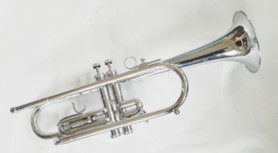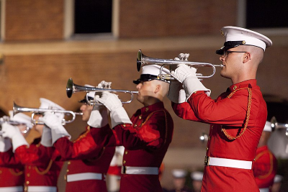This is a continuation of Part 1 and Part 2
In 1971 a number of drum and bugle corps were unhappy with the rules set by the American Legion and Veterans of Foreign Wars. The rule making committees of these veterans organization were not necessarily musicians and had a desire for preserving traditions and certain military aspects of the activity. A group of the largest corps, who wanted more artistic freedom, formed Drum Corps International (DCI) and established a competition circuit with a new set of rules.
In the late 1970s DCI began authorizing piston valve horns configured with two upright piston valves. These instruments are played the same as the first two valves on a standard concert trumpet. There was discussion of allowing three valve horns (similar to a concert trumpet) but the idea was scraped out of fear about copyright infringement issues and financial concerns for smaller corps. The roll-out of two-piston horns was phased over several years, starting with the soprano in 1977 and adding one more each year after.

Proposals to allow three-valved bugles were raised throughout the 1980s. This possibility was troublesome to the manufacturers who had only just retooled to manufacture the two-valve instruments. Eventually, in 1990, DCI adopted the three-valve bugles. Once again, the adoption was spread out over three years to allow corps to spread out the financial burden. DCI still maintained rules that all brass instruments had to be bell front and had to be in the key of G.
The drum corps activity in the United States declined in the late 20th century. Some manufacturers dropped out of the market or only made drum corps instruments as special order. The costs of making instruments in G for the small drum corps market were relatively high (for the quality of instrument) compared to traditional band instruments. Various advances for bell front instruments, however, such as over the shoulder tubas, were applied to the larger marching band market.
In 1999 DCI decided to allow multiple keyed brass instruments. This allowed corps to use instruments that were more readily available at better prices (such as Bb trumpet and F mellophones used in marching bands). The competition bugle manufacturing industry was practically eliminated. Dynasty continued for several years and Kanstul was one of the last American sources of G brass lines until the company closed in 2019. Reportedly, there are still Asian manufacturers making G brass lines which are used by Japanese drum corps.
This concludes the series on the horns used in American competition drum and bugle corps.

